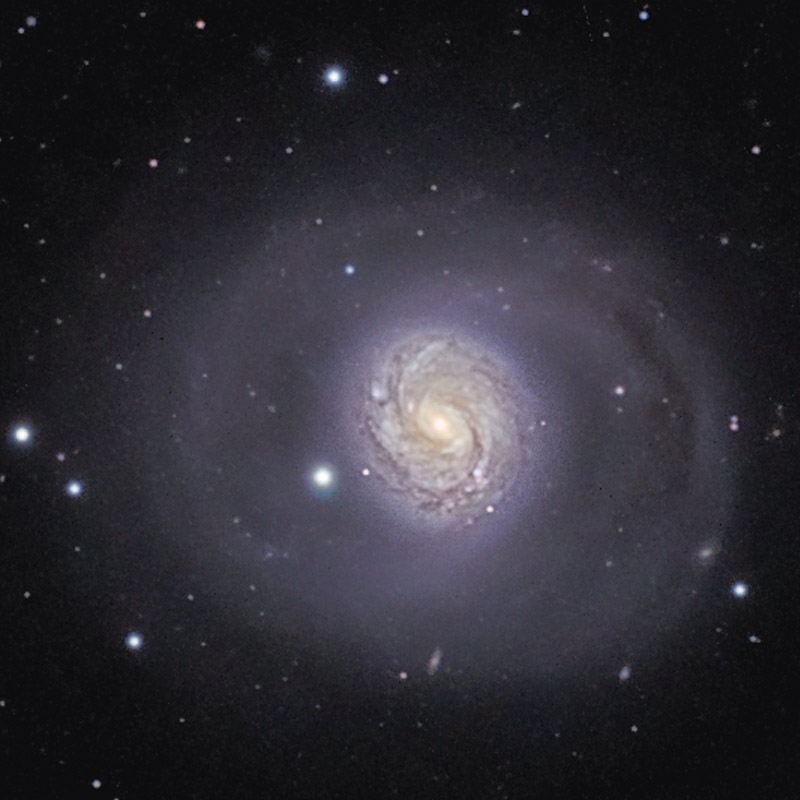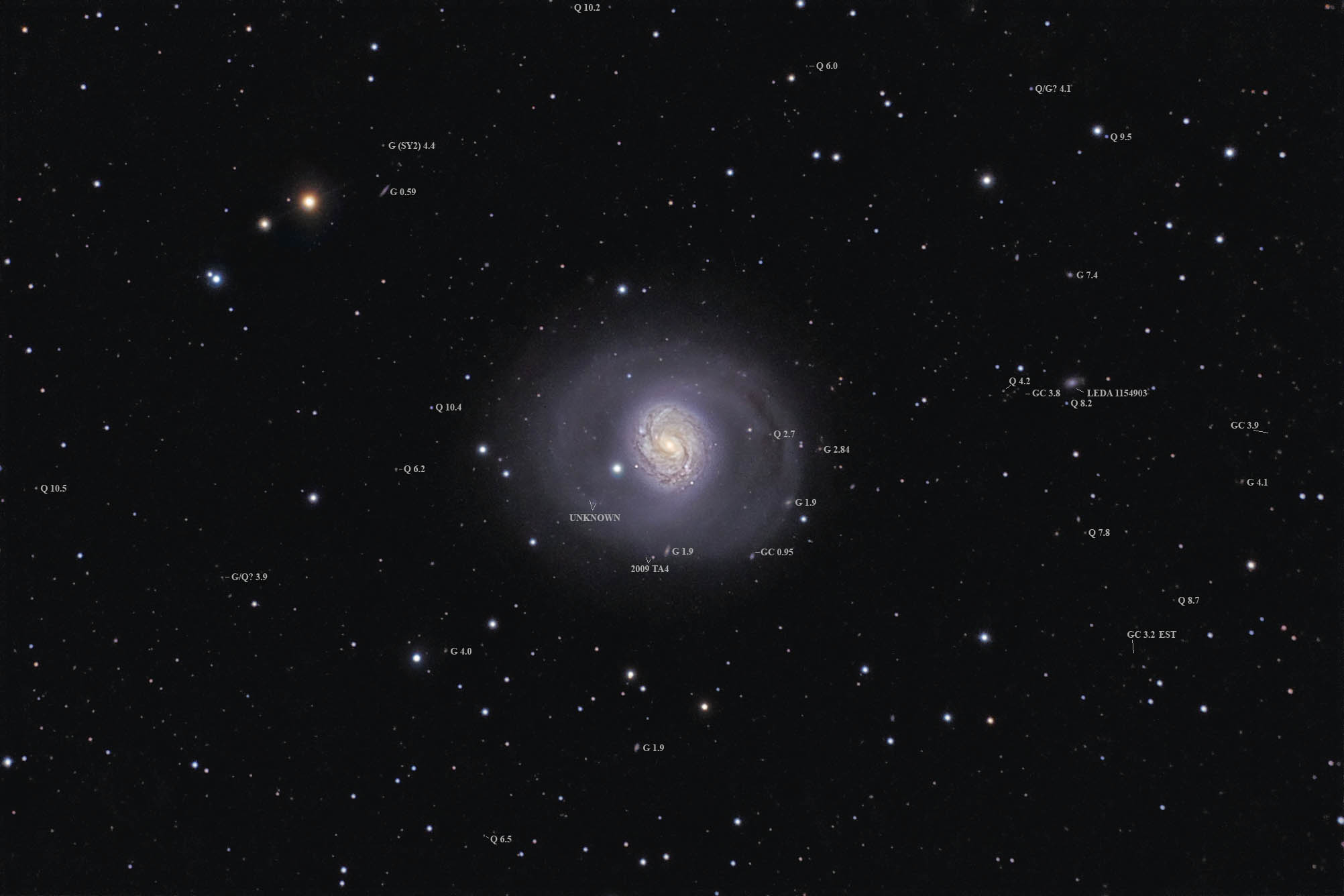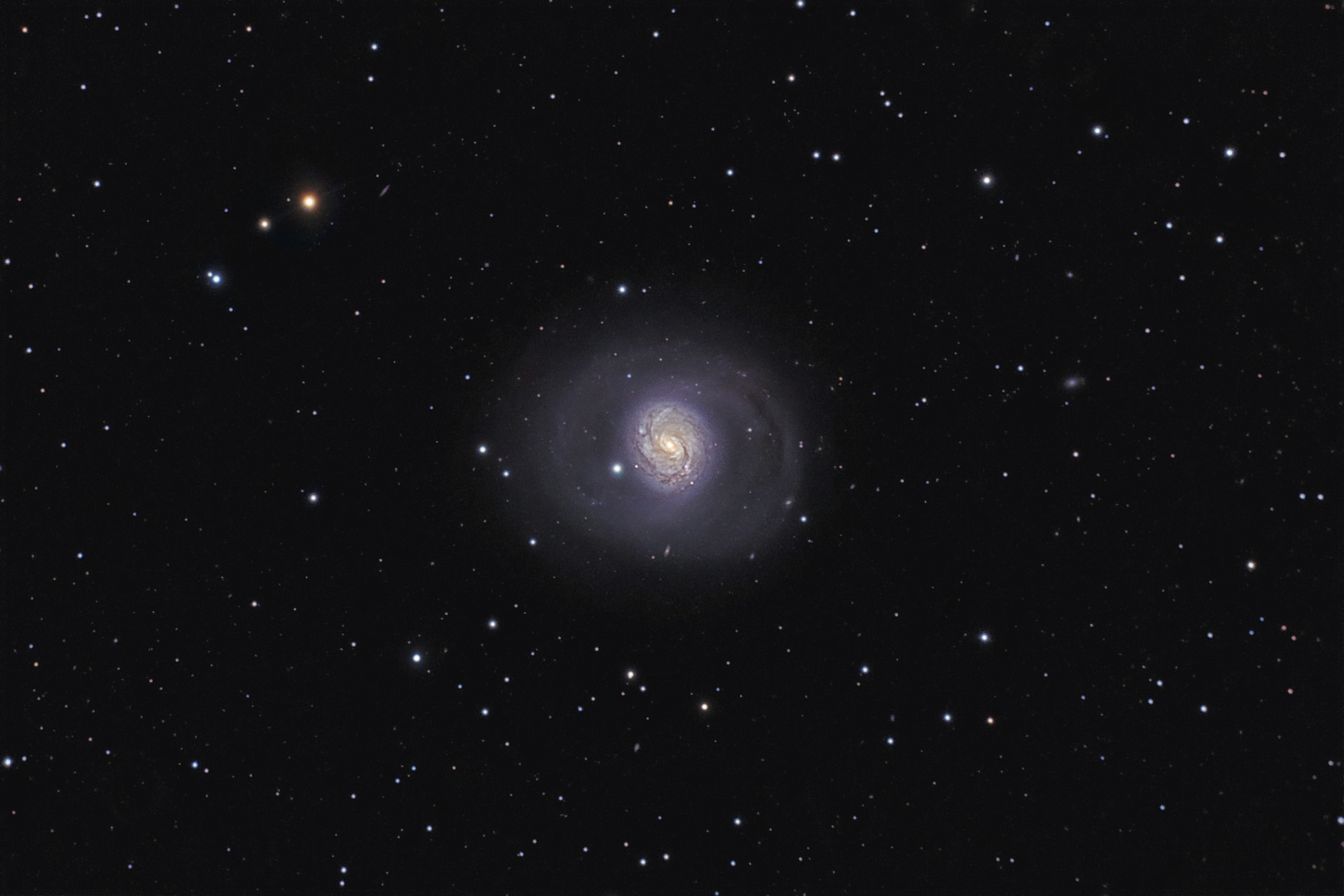Object name: ARP037Designation(s): ARP037, M077, Arp 37/M77 may be the most important entry in his catalog. Though not for the reason that he included it. Arp included it as the first entry under Spiral Galaxies with Companions on Arms: Low surface brightness companions. I can't even find the companion in Arp's image nor can I find anything in the literature on it.
Arp 37 is located in Cetus right on the celestial equator and is about 30 to 60 millions of light years distant. Even the Hubble images can't decide on a distance with one article in 1990 http://hubblesite.org/news_release/news/1990-13 saying 30 million light years and another in 1994 saying 60 million http://hubblesite.org/news_release/news/1994-07 while NED gives estimates of 33 to 47 million light years using Tully-Fisher measurements. Redshift isn't very reliable this close but does show 42 million light years. So spin the dial and pick a distance. Most sources say it is close to NGC 1055 in my previous post. But the distance to it is also all over the board but 60 million light years seems to be gaining popularity for it. For now, I'll go with that for Arp 37 as well.
While Arp says it has a low surface brightness companion on its arm I see at least 4 that could fit that description, All outside his image so can't be what he is seeing. The two with redshift distances are over a billion light years further away so meaningless to Arp 37's evolution.
In any case, this is unimportant. The galaxy is important for a far different reason. It is the archetypal example of a Seyfert galaxy. Quasars far outshine the galaxy they are in. Seyferts seem to have a similarly active core but one that isn't anywhere near as bright. They can be divided into two camps. Those with very broad emission lines indicating super high velocities for the gasses emitting this light and those with narrower lines indicating very high velocities, just not as high as the first group. The first is called Seyfert 1 and the second Seyfert 2. M77 is a Seyfert 2. But then things get complicated.
At one time it was thought the difference was age as quasars are seen mostly at distances of over 2 billion light-years with Seyfert 1 seen, on average, somewhat closer and Seyfert 2 galaxies tending to be closer yet. Since distance indicates age we are seeing quasars at a younger age of the universe than Seyfert 1 galaxies tend to reside with Seyfert 2 galaxies tending to be seen only in the more current universe. So is this due to the black hole that powers each having used up its easy fuel so not being as energetic as in the past? That has been the prevailing idea for some time now but studies of Arp 37 (M77) are causing some doubt.
Lately, this idea is falling somewhat out of favor though likely contains some truth. Study of M77 which Hubble and radio telescope arrays can see in fine detail is showing that we tend to see quasars fully face on to the jet emitted by the black hole. They are super bright since we are looking down their gun barrel. This greatly increases its brightness to where it overpowers the galaxy itself. Alignment is critical for this. We see them mostly in the early universe because we see a much higher volume of space and thus by the law of averages see more of them since there are more to see. Seyfert galaxies are just as common as today, just they are too faint to see at that distance because their light is blocked by the inner disk of the galaxy that surrounds the black hole. Only when they are close enough for the galaxy itself to be seen do we recognize their true nature.
Seyfert 1 galaxies have the jet tilted away from us so we don't see it directly but do see what they illuminate. Since we are seeing to near the core we see the high velocities involved. Seen at more of an angle these are hidden by the disk and we see only illuminated clouds further from the black hole and thus clouds with lower velocity. These are dimmer yet so must be closer, on average, for us to see and recognize them. We now can measure the angle of such disks and find those of the few Seyfert 1 galaxies we can measure aren't tilted as much as those of Seyfert 2 galaxies. So it is possible Quasars and Seyfert galaxies are really the same type of object, just that our view is more blocked in the case of Seyfert 1 and 2 galaxies by the inner core of the galaxy itself.
M77 is important here because while its basic spectrum screams Seyfert 2; by using techniques to peer into the hidden regions it shows a Seyfert 1 spectrum. It is both! Just that the Seyfert 1 characteristics are hidden behind the inner ring. Both are seen in a cone illuminated by its black hole. Some papers describe it as an overt Seyfert 2 and a hidden or closet Seyfert 1. NED recognizes this by classifying it as (R)SA(rs)b;Sy1 Sy2.
Both theories may carry some truth. Maybe the James Webb space telescope will further illuminate this situation (sorry, I couldn't resist).
I found more articles on this galaxy than any Arp galaxy I've researched. Far too many to even start to read. There must be over 1000 though I didn't try to count them. With that many, there must be at least one for every possible theory about this galaxy. So while this is my longest post, I had far more information available I could sort of understand. But I'm not done yet.
Besides the Seyfert angle, Arp 37 has a very large outer disk of faint stars. These are likely due to an interaction with another galaxy.
More on M77 can be found at http://www.seds.org/messier/m/m077.html which was discovered by Pierre Méchain on October 29, 1780 then verified and recorded by Charles Messier on December 17, 1780.
One aspect of my image bothered me when comparing mine to others. I see a faint blue halo about the main spiral. It is a bit brighter on the western side. I couldn't fathom any reason my processing could have done this. Then I came across this article about an ultraviolet halo in the galaxy. Its position seems to match my feature. Since my filters block UV light this makes no sense unless the halo is also seen in blue light. Probably not related but it does make me wonder.
http://apod.nasa.gov/apod/ap960910.html . The orientation of the linked image is the same as mine making the similarity easy to spot.
My image seems to fit the above description of quasar vs Seyfert perfectly as it contains many quasars and some Seyfert galaxies as well as two that seem to have characteristics of both. One more quasar-like (identified as Q/G? on the annotated image) and one more Seyfert like (G/Q?). Quasars range out to over 10 billion light years with a Seyfert 2 galaxy [G(SY2)] at 4.4 billion light years and several clusters over 3 billion light years distant. One cluster I've marked is behind Arp 37's outer arms and invisible in my image. I mark its center only because it is almost on top of one of the larger galaxies seen the disk, the only one without redshift value unless it is a member of the cluster. Unlikely, but they vary by only a few seconds of arc so thought it worth pointing out. Another cluster at about the same distance is also positioned behind the disk at the 2:30 position. I didn't mark it. All clusters marked are said to be 2 to 3 minutes in diameter. I've drawn a line to their approximate center. NED only gives their approximate position to an accuracy of +/- about 6 pixels.
There are two asteroids in the image, one of which isn't in the minor planet database. I've identified it as unknown. Several other similar streaks are seen in the outer disk of the galaxy, all are seen in their entirety in each subframe so aren't asteroids. The unknown, however, shows as a very slightly elongated object in each subframe so is a real moving object. Several have asked me why I don't take just one 40 minute frame. This is one of several reasons. It allows me to separate real asteroid trails from noise created impostors.
Arp's image:
http://ned.ipac.caltech.edu/level5/Arp/Figures/big_arp37.jpeg
Sloan image:
http://astronomerica.awardspace.com/SDSS-9/M77.php
14" LX200R @ f/10, L=4x10' RGB=3x10'x3, STL-11000XM, Paramount ME Related Designation(s):1AXG J024241-0000, 1ES 0240-002, 1H 0244+001, 1RXP J024240.9-000042, 1RXS J024240.9-000046, 1XMM J024240.7-000046, 2FGL J0242.5+0006, 2MASX J02424077-0000478, 2MASXi J0242407-000047, 2PBC J0242.7-0000, 2XMM J024240.7-000046, 2XMMp J024240.7-000046, 3C 071, 3FGL J0242.7-0001, 4C -00.13, 87GB[BWE91] 0240-0013, AFGL 4220S, AKARI J0242406-000039, ARP 037, ARP037, AT20G J024240-000046, CGCG 0240.1-0013, CGCG 388-098, CGS 161, Cul 0240-002, CXO J024240.79-000046.4, CXO J024240.8-000047, DA 082, FIRST J024240.7-000046, GC 0240-00, HDCE 0163 NED002, HIPASS J0242+00, IRAS 02401-0013, IRAS F02401-0013, ISOSS J02426-0000, KUG 0240-002, LDCE 0174 NED006, LGG 073:[G93] 002, LHE 067, LQAC 040-000 029, M077, MCG +00-07-083, MESSIER 077, MG1 J024240-0000, MRC 0240-002, MSH 02-014, NEWPS_5yr_5s 063, NEWPS_5yr_5s_15 062, NGC 1068, NGC 1068:[L2011a] X0001, NGC 1068:[LB2005] X01, NRAO 0112, NSA 023964, NSA 024009, NVSS J024240-000047, OD -067, PAPER J040.87+00.15, PBC J0242.7-0000, PGC 010266, PKS 0240-00, PKS B0240-002, PKS J0242-0000, PMN J0242-0000, RBS 0348, RX J0242.6+0000, RX J0242.6-0000, RX J0242.6-0000:[BEV98] 003, S3 0240-00, SWIFT J0242.6+0000, SWIFT J0242.9-0000, TXS 0240-002, UGC 02188, UITBOC 0219, USGC U143 NED02, UZC J024240.7-000048, VLSS J0242.6-0000, XSS J02445-0000, [AHG2014] B126, [BTM2013] 0144, [CRK2003] J0242.6-0000, [dML87] 057, [KRL2007] 025, [KWP81] 0240-00, [M98j] 041 NED07, [MHH96] J024239+000001, [MSC2011] J024240.71-000047.7 , [SLK2004] 0333, [VCV2001] J024240.7-000047, [VCV2006] J024240.7-000047, [WB92] 0240-0013, | | 

